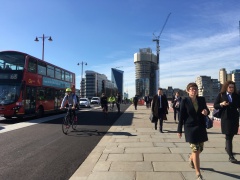Blackfriars Bridge Infra Wiki Skeleton
A completely specualtive example of what a infra wiki page could be like, to further discussion.

In Short: Bi-directional cycle track on Trunk Road with high capacity junciton with another main cycle route at one end.
Parent: London Cycle Superhighway 6 (North-South)
Where: [GPS coordinates etc., Openstreetmap ID, Geonames?]
Cost: Not separately quoted, but complete Cycle Superhighway 6 phase 1 scheme was £17.5m budgeted EFC, benefits costed as £107.6m over 30 years so a benefits:cost ratio of 6.6:1
Widths: [to add to streetmix] Pavement 5m, Cycle track 4m, Kerb 0.5m, 3m lane, 3.5m lane Median 0.5m, 3.5m lane, 3m bus lane, Pavement 4m [to check]
Widths vary over the scheme, but the cycle track has a typical width of 4m for a bidirectional track with no centre line marking.
Consultation: https://consultations.tfl.gov.uk/cycling/c1aec7da (3 Sep 2014 to 9 Nov 2014)
Consultation Results: 86% approval without including London Cycle Campaign form responses, 93% with (and 6,000 responses without and 12,000 responses with).
Approved by: TfL Board https://tfl.gov.uk/corporate/publications-and-reports/board-papers/2015-...(4th February 2015)
Jurisdiction: TfL road (TLRN) with some involvement from local councils (City of London to North, Southwark to South) and Network Rail (Blackfriars Station).
Construction: April 2015 - May 2016
Towards the end of construction an arrangement was made to open the part complete track northbound only using a ramp part-way along the bridge and cones to re-integrate people cycling into traffic in a somewhat controlled manner.
https://twitter.com/nuttyxander/status/717329092174094337
https://twitter.com/nuttyxander/status/719417792123052032
Opened: May 2016
Traffic Volumes: Last actual DfT Traffic Count was in 2011 (28th June) and it showed over 30,000 PCU of motor vehicles used this bridge every day. The cycle volume recorded then in the morning peak (7-10AM) was 1,238. In a more reliable count in 2013, the cycle volume over the same 7-10 time frame was 3,488. There are no published counts taken since the bridge had the cycletrack added, but TfL has said there has been a 55% increase in volumes of cycling and that cycles are now the dominant vehicle in rush hour making 70% of traffic. https://tfl.gov.uk/info-for/media/press-releases/2016/july/overwhelming-...
Traffic Speeds: There is a 20mph speed limit on the bridge and in the neighbouring authorities (Southwark and City of London) which TfL have also adopted. The bridge also had 20mph placed on it earlier due to construction work in the 2000s.

Overview: A bi-directional track, roughly 3m wide at level with the pavement on the West side of the bridge, connected as part of London's Cycle Superhighway 6 (CS6) to Farringdon to the North and Elephant and Castle to the South. Immediately to the North of the bridge itself is a junction with the East-West running Cycle Superhighway 3 (CS3), the two Superhighways meet at the North-East corner of the bridge where a former slip lane to join the Embankement has been converted into a bi-directional track linking them together. At the foot of this slip lane CS3 crosses over the A3211 as it enters the Blackfriars Underpass to head West whilst to go East it continues along the Emankment itself.
Key Elements: The bridge carries a bi-directional cycle track which is part of a larger scheme running north-south and incorporates signalised junctions with separation in time and space using high and low-level lights. As with much of the rest of CS6 green phases for cycling north-south run together with traffic in general lanes, with turning traffic held back for a later phase. There is a bus-stop bypass at the South end of the bridge which utilises a buff strip of anti-skid to provide a consrast and a suggested crossing along with some raised kerbing around the cycle track.
Legislation: The low-level lights on this bridge were agreed using a special authorisation after they had earlier been trialed at the TRL. However, those are now clear for use anywhere after TSRGD 2016 took effect.
Design Guidelines: The design of this and most other modern London cycle infrastructure, especially that led by TfL has been informed by the updated London Cycle Design Standards.
Wider Context: Blackfriars Bridge is one of eight road crossings in Central London, and has the most developed cycle infrastructure of any of them. Though Vauxhall Bridge and Southwark Bridge have segregated tracks upon each of them, those over Vauxhall are part of a shorter Cycle Superhighway and those over Southwark cover only the length of the bridge itself.

History: There had been debates and campaigning over the safety of Blackfriars Bridge for many years prior to the proposals for this scheme, led mainly by a series of avoidable deaths involving people on cycles being killed by collisions involving a large vehicle turning left over them to go from Blackfriars Bridge to Victoria Embankment. Incredibly some of that campaigning had to even fight an increase in speed limit proposed in 2008[?] after works to rebuild Blackfriars station. There was a very large scale and expensive junction scheme at that time which did little, if anything to improve the situation. It was only with the Cycle Vision and the later, reworked phase of the Cycle Superhighway plans that plans of higher quality came forward.
Where Had It Been Done Before: Bi-directional crossings on bridges are common in the Netherlands but were not without precedent in the UK. Crossings such as the Forth and Severn Bridges for road traffic were built with cycle lanes that could be used in either direction. And in Central London, the Blackfriars Bridge cycle-track was preceeded by the similar track over Vauxhall Bridge (authorised at the same time in February 2015) by a few months [March 2015?]. [Also Kingston? Chiswick? - need to explain quality and width and part of wider route?]



